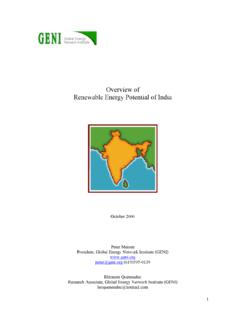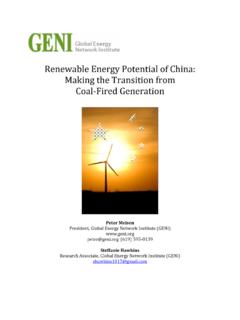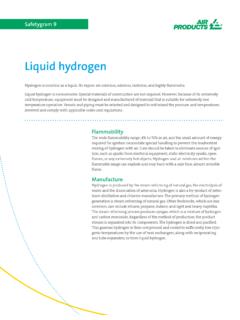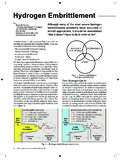Transcription of Hydrogen for Large-scale Electricity Generation in …
1 Hydrogen for Large-scale Electricity Generation in USA. September 2011. Deepak Prakash Research Associate, Global Energy Network Institute (GENI). Under the Supervision of and edited by Peter Meisen President, Global Energy Network Institute (GENI). (619) 595-0139. Table of Contents Abstract . 2. 1 The role of Hydrogen in Electric Power Sector .. 3. 2 Hydrogen from Renewables .. 8. Resource Assessment .. 8. Resource Analysis Results .. 10. 3 Hydrogen Production, Handling and Delivery .. 11. Hydrogen Production Electrolysis .. 11. Hydrogen Production Electrolysis . 11. Hydrogen Production Electrolysis Cost .. 11. Hydrogen Handling .. 13. Hydrogen Handling - Liquefaction .. 13. Hydrogen handling Gaseous Hydrogen Compression .. 13. Hydrogen Delivery to the Power .14. Hydrogen Delivery to the Power Plants - Road Delivery .. 14. Hydrogen Delivery to the Power Plants - Pipelines ..16. 4 Hydrogen in Gas Turbines.
2 17. Hydrogen as a Gas Turbine .. 17. Hydrogen in IGCC power plants .. 18. Hydrogen in IRCC power plants .. 19. 5 Strategies for integration of Hydrogen in Electric Power Sector .. 21. Using Natural Gas pipelines for transporting Hydrogen .. 21. Centralized Hydrogen storage in Power plants .. 22. Production of Hydrogen from power plants during Off-peak hours .. 22. Flow model .. 23. 6 Conclusion . 24. Table of Figures 1 Figure Specific Energy of fuels .. 3. 2 Figure 2009 US Electricity Generation by source .. 4. 3 Figure Emissions based on economic sectors .. 5. 4 Figure Model for Hydrogen usage .. 7. 5 Figure - Hydrogen Potential (kg of Hydrogen ) normalized by county area .. 10. 6 Figure - Electrolysis .. 11. 7 Figure - Capacities of Delivery options .. 14. 8 Figure Road Delivery Options .. 15. 9 Figure Pipelines .. 16. 10 Figure Integrated Gasification Combined Cycle .. 19. 11 Figure Integrated Reforming Combined Cycle 20.
3 12 Figure Flow .. 18. Abstract In the recent years, there has been a lot of interest in examining clean energy options. It is now recognized that our energy solutions must include a combination of various technologies integrated with energy storage and smart grid approaches. Even now, our energy comes mainly from fossil fuels like coal, oil and natural gas. The electric power sector is still largely dependent on fossil-fuel-based model. The growing concerns regarding climate change have necessitated implementation of norms for mitigating greenhouse gas emissions. The electric power sector is the most important contributor to emissions. There is urgent need to change the existing system of Electricity Generation to make use of clean, renewable energy sources. But this change cannot take place all of a sudden. There must be a steady, gradual change of the methods. Hydrogen derived from renewable sources is a clean energy resource.
4 Burning it produces only water. Using Hydrogen as transportation fuel and for distributed power Generation in fuel cells is already being studied and in some places implemented. Hydrogen can also be used for utility scale Electricity Generation in power plants to mitigate emissions. This study is concerned with the feasibility of using Hydrogen for Large-scale Electricity Generation in power plants. A renewable resource assessment in United States is made to know the potential for Hydrogen production. Then, various methods of Hydrogen production, handling and delivery are studied. The use of Hydrogen as a fuel in turbines is also studied along with some strategies that can be employed to make the model realizable in the near future. Overall, the results of the study give a positive indication that Hydrogen can be made use of in the electric power sector. The consequences will be highly beneficial not only to mitigate the emissions problem but also to encourage the utilization of more renewable resources to produce Hydrogen .
5 2. 1. The role of Hydrogen in Electric Power sector Hydrogen is the simplest and most abundant element in the universe. It makes up about 75% of all matter in the universe. It is a basic element with tremendous potential. It is a non-metallic element with atomic number 1. Hydrogen gas or molecular Hydrogen consists of two atoms of Hydrogen held together by a covalent bond. Hydrogen produces clean energy. When oxidized, or combined chemically with oxygen, its only byproducts are heat and pure water. This is why Hydrogen bears so much promise as a source of clean energy. H2 + O2 ------------- H2O. The energy content of Hydrogen is much higher in comparison to other normal fuels like gasolene, coal and natural gas. Specific energy is the energy content of the fuel per unit mass. The specific energy of Hydrogen is 141 kilo Joules per gram which is roughly thrice that of gasoline. The below figure gives a comparison of specific energies of different common fuels 1.
6 Figure 1: Energies of different common fuels 1. Source: 3. In the United States of America, electric power sector still largely depends on the fossil fuels. The figure below2 shows that coal, natural gas and petroleum constitute to about 70 % of the total sources of Electricity production as of 2009. The rest of the sources include renewables and nuclear energy. Figure 2: 2009 Electricity Generation by Source In 1992, the United States signed and ratified United Nations Framework Convention on Climate Change (UNFCCC). As stated in Article 2 of the UNFCCC, The ultimate objective of this Convention and any related legal instruments that the Conference of the Parties may adopt is to achieve, in accordance with the relevant provisions of the Convention, stabilization of greenhouse gas concentrations in the atmosphere at a level that would prevent dangerous anthropogenic interference with the climate system.
7 Such a level should be achieved within a time-frame sufficient to allow ecosystems to adapt naturally to climate change, to ensure that food production is not threatened and to enable economic development to proceed in a sustainable manner.. 2. Source: Wikipedia Electricity Generation . 4. The table below gives the data of US greenhouse gas emissions allocated to different economic sectors. It shows that Electric Power Industry is the major contributor to the emissions over the years. It accounts for about 33% of the total emissions as per 2009 Table 1: US Greenhouse Gas Emissions by Sector The figure below shows the data collected in a graphical form. Electric Power Industry accounts for major portion of the emissions in US. Figure 3: US Greenhouse Gas Emissions by Sector 3. Inventory of Greenhouse Gas Emissions and Sinks 1990-2009 -Executive summary- US EPA. 5. Thus, there is an urgent need for modifying the existing fossil-fuel-based Electricity Generation methods.
8 In order to meet the growing demands for electrical energy and at the same time, to mitigate the problems caused by green house gas emissions, we need to look for the right combination of clean energy sources as well as energy storage technologies. Along with the development of renewable energy sources, the existing methods of Electricity Generation need to be modified. Hydrogen can serve the purpose! The flexibility of Hydrogen allows for its integration in many areas of the system. Hydrogen can act as a clean fuel, which can be combusted in gas turbines to generate Electricity . It can also be used as a transportation fuel like gasolene in Hydrogen internal combustion engines. It can be used in fuel cell based automobiles to generate Electricity electrochemically. It can be used in distributed power Generation systems using fuel cells to cater to the Electricity need of an office or a small community.
9 Hydrogen is an energy carrier like Electricity . Just like Electricity carries energy by transmission lines from power plants to the end users, Hydrogen can be employed to carry energy from its source point to the end users by pipelines. Hydrogen is successfully used as an energy storage medium. The options for Electricity storage with the present battery technologies offer many drawbacks. Thus, Electricity is used as it is produced. By integrating Hydrogen in the system and storing Electricity , it is possible to make better use of surplus renewable resources. The idea is to produce Hydrogen from the renewable Electricity generated by solar, wind, biomass and other sources. Hydrogen thus produced can be integrated in transportation sector, distributed Electricity Generation and also utility- scale Electricity Generation . Thus, Hydrogen generated from renewables can be combusted in power plants to produce Electricity .
10 This process will not only help in utilizing and developing the renewable technologies, but also will help in mitigating emissions. The figure below shows schematic representation of the model. 6. Model End Users Electricity Renewables Power plants Hydrogen Transportation Fuel Fuel Cells Figure 4: Model for Hydrogen generated from renewables The current gas turbines run on natural gas. In order to use Hydrogen in place of natural gas, some modifications are required to be made. Various companies in the power sector are developing Hydrogen turbines. For the current power plants which use fossil fuels, technologies are already in place for carbon capture and sequestration. The carbon is separated from hydrocarbons and Hydrogen is used in the turbines. Additional supply of Hydrogen from renewables can be incorporated. Successful integration of Hydrogen in the above model involves the study of all stages starting from renewable resource assessment to the use of Hydrogen in turbines.










